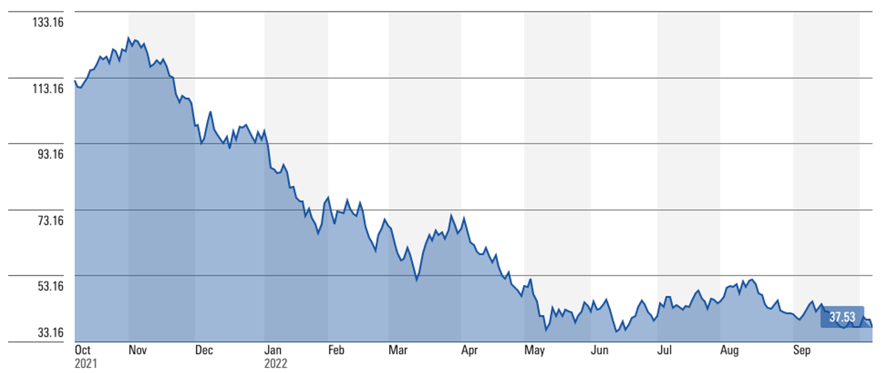If you're investing in highly diversified portfolios right now, keep adding money. You have ground beneath your feet. Everyone else is on thin ice
I learned to ice skate on a frozen lake in Canada.
Sometimes, freakishly warm winds, known as Chinooks, blew in overnight.
The warm days that followed, especially if they were sunny, drew more skaters to that lake.
Teenagers often played hockey far from the shore where the water was deep and the ice could be thin.
Many of the boys went shirtless as they zipped around on blades or basked in the sun.
And as the day got warmer, more kids came to play.
They laughed.
They celebrated goals.
None of them thought about life and death.
They were invincible.
Unfortunately, every Canadian town and city has its share of sad, ice-breaking stories.
Over the past few years, plenty of investments were warm-wind Chinooks.
They lured hopeful people onto increasingly thin ice.
I watched a smart otherwise rational friend put much of his life savings in Bitcoin in November last year.
He “invested” $500,000.
Now worth $166,000, it seems like it’s plunging to the bottom of that lake.
He pegged hopes on Bitcoin because its price was going up.
Like a young hockey player beside a warming, frozen lake, he couldn’t help but skate towards the laughter and the fun.
Will Bitcoin recover?
Maybe.
But unlike thousands of actual businesses (which you could own with a diversified portfolio of index funds) Bitcoin doesn’t have a measurable intrinsic value.
But giddy hopes spread further than the crypto siren’s call.
In June 2021, I profiled two UAE-based investors in a story for Canada’s Globe and Mail.
They were among thousands of hopefuls scrambling to buy Cathie Wood’s Next Generation ARK ETFs.
The funds had recently jumped a lot.
Each person I profiled expected to earn more than 20 percent per year over the following ten years.
But as I mentioned in that article, this was another thin-ice move.
After all, Wood, who became famous in 2020 for having the best-performing funds in the world that year, had stuffed her funds almost exclusively with stocks of companies that were not making money.
To be clear, the stocks were rising on hope.
But the businesses representing those stocks were losing a lot of money.
That made them thin-ice bets.
Since that article was published in June 2021, Wood’s flagship ARK fund is down 66 percent.
From January 1st to October 10, 2022, it sank 61.62 percent.
ARK Innovation ETF Sinks
January 1, 2022 to October 10, 2022

Will the ARK funds recover?
Maybe.
But the businesses within those funds will need to start making money.
In contrast, if you own a diversified portfolio of index funds, you own businesses that already make money.
They make a lot of money.
And almost every year, those companies make more.
That’s why globally diversified portfolios always eventually recover after the markets drop.
For other investors, however, that recovery could be longer.
Plenty of people flooded into tech stocks last year, including the popular FANMAG stocks: Facebook, Apple, Netflix, Microsoft, Amazon and Google (Alphabet).
Unlike Cathie Wood’s ARK funds and Bitcoin, those companies produce huge profits.
But because their popularity increased faster than their business growth, they were destined to crash.
But like breaking ice, nobody knew when that would happen.
A stock’s price always aligns, long-term, with its business growth.
For example, over the past several years, Facebook’s stock price increased far faster than Facebook’s business profits.
When realignment occurs, such stocks fall hard.
That’s why, as a group, the FANMAG stocks sank almost 40 percent from January 1 to October 10, 2022.
Will they recover?
Probably.
But their stock prices increased so much faster than their business earnings that it could take years.
This brings us back to a globally diversified portfolio of index funds.
So far, such portfolios have also fallen this year.
As shown below, if someone invested 60 percent in global stocks and 40 percent in global bonds that money would have dropped 20.7 percent to October 10, 2022.
January 1 to October 10, 2022
| Investment | Performance | $100,000 fell to... |
|
Globally Diversified Index Portfolio: 60% Global Stocks, 40% Global Bonds |
-20.7% | $79,300 |
| ARK Innovation ETF | -61.62% | $38,380 |
| Bitcoin | -60.02% | $39,980 |
|
FANMAG Stocks: Facebook, Apple, Netflix, Microsoft, Amazon, Google (Alphabet) |
-39.56% | $51,440 |
Source: Morningstar
However, a diversified portfolio is different in many ways.
Yes, it includes all the FANMAG stocks.
However, it also includes thousands of other companies.
Many of those stocks weren’t overpriced because their prices hadn’t risen faster than their corporate business earnings.
That’s why investors in diversified portfolios should keep adding money.
They have ground beneath their feet.
And when markets recover, they’ll rise above that frozen lake while plenty of others will be swimming with the fishes.
Andrew Hallam is the best-selling author of Millionaire Expat (3rd edition), Balance, and Millionaire Teacher.

